Zoom
Trash

Strategic Leadership Competencies. Develop Strategic Thinkers Throughout Your Organization. In study after study, strategic thinkers are found to be among the most highly effective leaders.

And while there is an abundance of courses, books, articles and opinions on the process of strategic planning, the focus is typically on an isolated process that might happen once or twice per year. In contrast, a true strategic leader thinks and acts strategically every day. So is there a way to encourage routine strategic thinking throughout the organization? I would say yes – and that it’s the most important thing you can do as a leader. In 2013, Management Research Group (MRG) completed a large scale global study addressing this question. We found that a strategic approach to leadership was, on average, 10 times more important to the perception of effectiveness than other behaviors studied. Strengthen Your Strategic Thinking Muscles - Liane Davey. By Liane Davey | 1:00 PM January 21, 2014 Have you been told that you need to be more strategic?

Whether through 360 feedback or after a failed promotion attempt, being told that you aren’t strategic enough really stings. Worse is when you try to clarify what “more strategic” would look like and get few tangible suggestions. Being more strategic doesn’t mean making decisions that affect the whole organization or allocating scarce budget dollars. How to be a BETTER STRATEGIC Thinker.
4 Steps to Customizing Your Strategic Thinking Questions. Yesterday’s Brainzooming article shared ways to increase the strategic thinking in your organization without holding an offsite meeting.
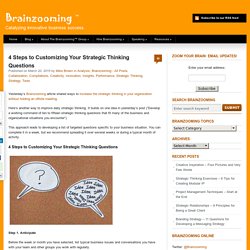
Management planning and the future. Managers who think about the future - which should, of course, mean all managers - are accustomed to approaching the task with logical, careful analysis of what (or so they think) is most likely to happen.
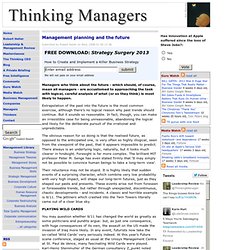
Extrapolation of the past into the future is the most common exercise, although there’s no logical reason why past trends should continue. But it sounds so reasonable. In fact, though, you can make an irresistible case for being unreasonable, abandoning the logical and likely for the deliberate pursuit of the irrational and unpredictable. The obvious reason for so doing is that the realised future, as opposed to the anticipated one, is very often so highly illogical, seen from the viewpoint of the past, that it appears impossible to predict.
There always is an underlying logic, naturally, but it looks much clearer in hindsight. Their reluctance may not be stupid. . • Will the trends continue to favour our business? For ‘possibility’ read ‘probability’; Wild Cards are inevitable. CONTENTS. 6 Habits of True Strategic Thinkers. In the beginning, there was just you and your partners.
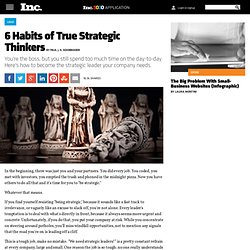
You did every job. You coded, you met with investors, you emptied the trash and phoned in the midnight pizza. Now you have others to do all that and it's time for you to "be strategic. " Whatever that means. If you find yourself resisting "being strategic," because it sounds like a fast track to irrelevance, or vaguely like an excuse to slack off, you're not alone. This is a tough job, make no mistake. After two decades of advising organizations large and small, my colleagues and I have formed a clear idea of what's required of you in this role.
Anticipate Most of the focus at most companies is on what’s directly ahead. 10 Big Mistakes People Make in Thinking About the Future. Photo Credit: Frank Peters Being a working futurist means that I think a lot about how people think about the future.
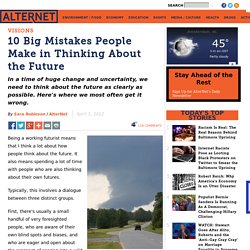
It also means spending a lot of time with people who are also thinking about their own futures. Typically, this involves a dialogue between three distinct groups. First, there's usually a small handful of very foresighted people, who are aware of their own blind spots and biases, and who are eager and open about the prospect of soaring into a wild blue sky to gather a lot of exciting new information. Strategic Planning. Strategic Thinking Exercises – More than 200 Strategic Planning Questions. Productive strategic thinking exercises are at the heart of The Brainzooming Group methodology.
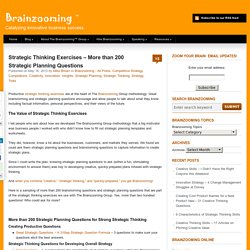
Great brainstorming and strategic planning questions encourage and allow people to talk about what they know including factual information, personal perspectives, and their views of the future. The Value of Strategic Thinking Exercises I tell people who ask about how we developed The Brainzooming Group methodology that a big motivator was business people I worked with who didn’t know how to fill out strategic planning templates and worksheets. They did, however, know a lot about the businesses, customers, and markets they served. Business Model Canvas. Business Model Canvas: nine business model building blocks, Osterwalder, Pigneur & al. 2010 The Business Model Canvas is a strategic management and lean startup template for developing new or documenting existing business models.[1][2] It is a visual chart with elements describing a firm's or product's value proposition, infrastructure, customers, and finances.[3] It assists firms in aligning their activities by illustrating potential trade-offs.
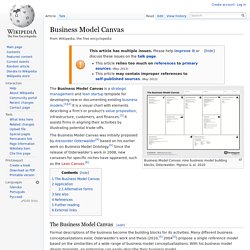
The Business Model Canvas was initially proposed by Alexander Osterwalder[4] based on his earlier work on Business Model Ontology.[5] Since the release of Osterwalder's work in 2008, new canvases for specific niches have appeared, such as the Lean Canvas.[6] The Business Model Canvas[edit] Formal descriptions of the business become the building blocks for its activities. InfrastructureKey Activities: The most important activities in executing a company's value proposition. Application[edit] Alternative forms[edit] Business Model Fiddle. Porter's 5 Forces Exercise/Quiz. Core Competence Analysis - Problem Solving Techniques from MindTools. Building Sustainable Competitive Advantage.
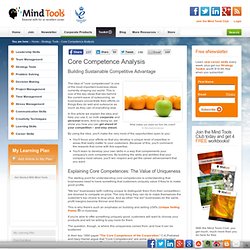
Main Page - ScenarioThinking. Strategic Thinking Exercises - 13 Point Strategic Change Management Checklist. As we mentioned recently, we’re on the lookout everywhere for strategic thinking exercises to share.
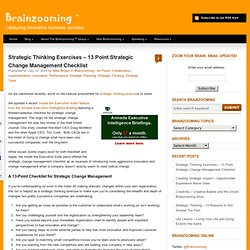
We spotted a recent “Inside the Executive Suite” feature from the Armada Executive Intelligence Briefing featuring a thirteen-question checklist for strategic change management. The origin for the strategic change management list was two stories in the Wall Street Journal. One story covered Wal-Mart CEO Doug McMillon and the other Apple CEO, Tim Cook. Both CEOs are in the midst of trying to change what have been very successful companies over the long-term. While issues (some major) exist for both Wal-Mart and Apple, the Inside the Executive Suite piece offered the strategic change management checklist as an example of introducing more aggressive innovation and change management when a company doesn’t exactly seem to need radical change.
Strategic Planning Benefits – 18 Ways Strategic Planning Helps Your Organization. I’ll admit to being hopeful about the strategic planning benefits an organization can realize. But not from the typical strategic planning – the kind with too many boring meetings, too few real insights, lots of forms to fill out, takes forever with little real world impact. Instead, my hopefulness is tied to the type of strategic planning we facilitate with: When it comes to that kind of strategic planning, there are plenty of benefits for an organization. Strategic HR Planning.